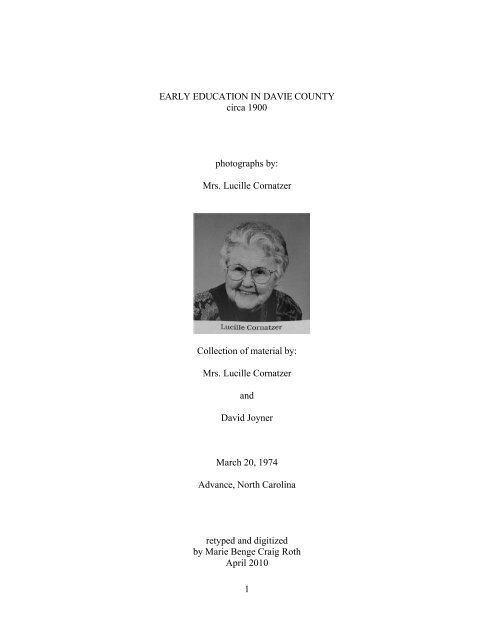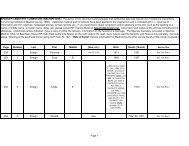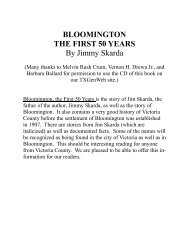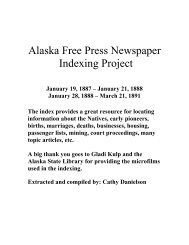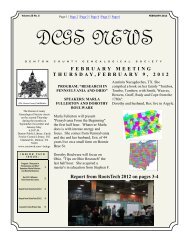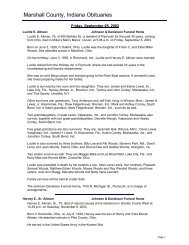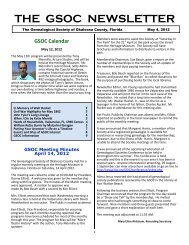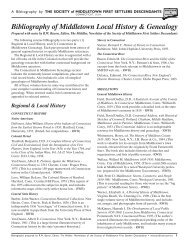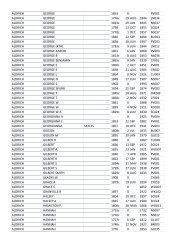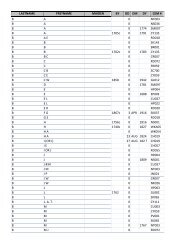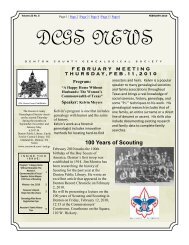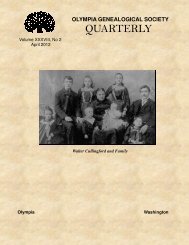EARLY EDUCATION IN DAVIE COUNTY circa 1900 ... - RootsWeb
EARLY EDUCATION IN DAVIE COUNTY circa 1900 ... - RootsWeb
EARLY EDUCATION IN DAVIE COUNTY circa 1900 ... - RootsWeb
Create successful ePaper yourself
Turn your PDF publications into a flip-book with our unique Google optimized e-Paper software.
<strong>EARLY</strong> <strong>EDUCATION</strong> <strong>IN</strong> <strong>DAVIE</strong> <strong>COUNTY</strong><br />
<strong>circa</strong> <strong>1900</strong><br />
photographs by:<br />
Mrs. Lucille Cornatzer<br />
Collection of material by:<br />
Mrs. Lucille Cornatzer<br />
and<br />
David Joyner<br />
March 20, 1974<br />
Advance, North Carolina<br />
retyped and digitized<br />
by Marie Benge Craig Roth<br />
April 2010<br />
1
THE MOVEMENT FOR BETTER SCHOOLS<br />
There were many reasons why North Carolina made slow progress in education after the war. (Civil<br />
War). The low income and poverty of the people, the bad roads and scattered population, and the large<br />
number of children made it very difficult to have a good school in reach of every child. The schools<br />
that were set up were poor because the teachers were not well trained, buildings and equipment were<br />
poor, and classes were too large.<br />
Slowly, though, the friends of public education gained in strength. By 1890 there was a strong<br />
movement for better schools. Manufacturing and trade had caused a great increase in the towns of<br />
wealth, crops were larger, and the state was now wealthy enough to spend more money for education.<br />
The farmers had begun to organize. They demanded that the businessmen be forced to pay their fair<br />
share of taxes. Then the state would have more money for public schools.<br />
Then, too, a group of young leaders was urging, that public education was the only sure road to<br />
progress. In 1899 Charles D. McIver and Edwin A. Alderman were sent by the state into every county<br />
to train teachers and to speak to the people about the need for public education. For three years these<br />
men preached education and made many thousands of people willing to pay taxes for schools.<br />
Ignorance is more costly than good schools, they said. In Raleigh, Walter Hines Page, a young editor,<br />
had been trying to wake the state. L.L. Polk and Marion Butler were urging the farmers to support<br />
schools and colleges. In Goldsboro Charles B. Aycock was a friend of public education.<br />
The legislature provided more money for schools and required the people of every school district to pay<br />
or vote on the question of local school tax. Now the Democratic party was restored to state power with<br />
younger leaders who were in favor of progress.<br />
The Democrats voted more money for public schools and elected Charles B. Aycock governor in <strong>1900</strong><br />
on the promise to set up better public school for all white and Negro students. With Aycock a new age<br />
of public education opened in North Carolina.<br />
Hugh T. Lefler<br />
1969 Edition of<br />
North Carolina – History Geography and Government<br />
2
TABLE OF CONTENTS<br />
Fork Academy, Fork Community Building 4<br />
Cokesbury Methodist School 5<br />
South Advance Academy, Shutt 6<br />
Elbaville Community School 7<br />
Fulton or Smithfield School 8<br />
North Advance Academy, Community Building 9<br />
Piney Grove School 10<br />
Cornatzer School 11<br />
Jarvis School 12<br />
R. L. Ellis School 13<br />
Dulins School 14<br />
Hartmans School 15<br />
Baltimore School 16<br />
Redland School 17<br />
Mt. Zion School 18<br />
Greenwood School 19<br />
Beauchamp School 20<br />
Howard School 21<br />
Hairstons School 22<br />
ACKNOWLEDGEMENTS<br />
1. Report prepared by Mrs. H. C. Cornatzer on the Davie County Schools. (1965)<br />
2. James Wall, History of Davie County, 1969; pages 222-223.<br />
3. The Flossie Martin Collection contains several accounts of various schools in Davie County.<br />
3
FORK ACADEMY, FORK COMMUNITY BUILD<strong>IN</strong>G<br />
(Fulton Township, Fork Church Community)<br />
1. In 1879, the congregation of the Fork Baptist Church decided to sponsor an academy with the<br />
“...object of providing a more excellent training of its young people for service.”<br />
2. The trustees bought a lot from Dr. Milton Hobbs next to the church to erect a two story frame<br />
building which was completed in October of 1879.<br />
3. The first principal was C.A. Rominger, a Wake Forest graduate. He taught three years and was<br />
followed by J.T. Alderman, another Wake Forest graduate who taught from 1882 to 1892.<br />
Wilson Merrell became principal in 1901 and taught until 1915. He left much history on the<br />
Fork Baptist Church.<br />
4. The Davie County Board of Education sold the Academy in July of 1919 for $700.00.<br />
5. The school was blown off its foundation in 1961 during a storm.<br />
4
COKESBURY METHODIST SCHOOL<br />
(Shady Grove Township, Advance Community)<br />
1. Organized in 1793.<br />
2. Named for Thomas Coke and Francis S. Asbury.<br />
3. Located in the Samuel Bryan area, high above the Yadkin River on the present (1974) land of<br />
Taylor Bailey.<br />
4. Built on six large cornerstones.<br />
5. Bishop Asbury preached there in 1799.<br />
6. Built near Phelps Ferry (Aquila Phelps Horse Ford) near the present (1974) Idols Dam.<br />
7. The first Methodist sponsored school in North Carolina<br />
8. Asbury wrote in 1793 (or April 1794), the school stood:<br />
“...on a beautiful eminence and overlooked the low-lands and river Yadkin.”<br />
“...twenty feet square, two stories and well set out with doors and windows.”<br />
described how the school looked. On October 12, 1799 he wrote the following in his<br />
journal: “...said but at the academical school house, now a house for God.”<br />
9. James Parks, an able minister and teacher was the principal of the school.<br />
10. Hanes Cemetery is nearby.<br />
11. Cokesbury School eventually became the present Advance United Methodist Church in<br />
Advance.<br />
12. John Dickens prepared the first plan for a Methodist school in America, and the first money<br />
ever given for Methodist education was donated by Gabriel Long and a Mr. Bustion. Asbury<br />
called the school “a Kingswood School in America.” Presumably it was to be in N.C. And a<br />
Cokesbury School was actually established.<br />
13. James Parks, son-in-law of Hardy Jones who lived on the site of the school was taken from the<br />
district and became principal of the school.<br />
5
SOUTH ADVANCE ACADEMY<br />
Shutt School 1906<br />
Shutt School was located on Shutt Road approximately Ç mile down the road to the left. Photographs<br />
have shown some 50 students (13 named Shutt) and the teacher was Miss Tullah Byerly.<br />
Students named Shutt:<br />
Willie Lee Shutt<br />
Grover Deloss Shutt<br />
Leonard Wesley Shutt<br />
Walter Monroe Shutt<br />
Mattie Viola Shutt, Lydia Holder (mother a Shutt)<br />
Ella Crawford Shutt<br />
Laura Eugenia Shutt<br />
Albert Holder (mother a Shutt)<br />
Arthur Lee Shutt<br />
Mary Eliza Shutt<br />
Alma Viola Shutt<br />
Other students:<br />
Luke Orrell<br />
Rufus Markland<br />
Naylor Foster<br />
Grace Faircloth<br />
Agnes Peebles<br />
Nan Jones<br />
Ethel Tucker<br />
Clara Jones<br />
Emma Markland<br />
Frances McMahon<br />
Mammie Markland<br />
Clara Orrell<br />
Annie Faircloth<br />
Maggie Sidden<br />
Ollie Hege<br />
Walter Peebles<br />
Paul Peebles<br />
William Glenn White<br />
Ruth Jones<br />
Lucille Peebles<br />
Myrtle March<br />
Julia Jones<br />
Ann Foster<br />
Roscoe White<br />
Preacher Scales was at the Methodist Church at this time. Four of his children are in the picture, but<br />
don't know them.<br />
6
WILLY PHELPS SCHOOL OR ELBAVILLE SCHOOL<br />
(Shady Grove Township, Elbaville Community)<br />
1. In 1858, Jerimiah Ellis to _____ Holton, Thomas Fry, Alexander Robbins, George Sidden,<br />
James Thorton, Elan. Gaither and Oarand Weisman of Davie, Davie, Davidson, Forsyth, Randolph, and<br />
Iredell counties, 5 acres of land “for building an seminery of learning and house for worship of the<br />
almighty God under the control of the Methodist Protestant Church.<br />
Land lying on the east side of the public road from Fulton to Clemmonsville; 2 mile<br />
north of Fulton. Joining the property of L. Chaffin and Thomas Ellis.<br />
2. The old Willy Phelps farm used to be a school.<br />
3. Located on the site of the present Elbaville United Methodist Church.<br />
4. Teachers: Delia Crouse, Ethel Smithdeal, Foda Lee Sterch, Luther Crouse, Edna Ward, Charlie<br />
Boardway, Lelia Martin and Lily Merony<br />
5. Sold in the 1920's to the Elbaville Methodist Protestant Church by the Board of Education.<br />
6. Partial list of those attending:<br />
Lula Lyons Dragg<br />
Patti Lyons<br />
Genevera Lyons Robertson<br />
Earnest Markland<br />
Lloyld Markland<br />
Joe Markland<br />
Amanda Waller Frye<br />
Rosie Waller Jones<br />
Nat Waller<br />
Kelly Waller<br />
Sadie Waller Jones<br />
Mamie Markland Myers<br />
Ada Mae Tucker<br />
Emma Tucker Cook<br />
Blanche Tucker Foster<br />
Ruth Waller Waller<br />
Sudie Tucker Jones<br />
Annie Tucker<br />
Kate Tucker<br />
Charlie Tucker<br />
J.T. Tucker<br />
Bailey Tucker<br />
D.S. Tucker<br />
Alec Tucker<br />
Frank (Son) Tucker<br />
Luretta Orrell Koontz<br />
Lizet (Liz) Markland<br />
Annie Jarvis Myers<br />
Ollie Myers<br />
Thomas Ellis<br />
Mildred Ellis Hege<br />
Bill Ellis<br />
7
FULTON<br />
(Fulton Township, Fulton Community)<br />
1. School was held in the old Hanes home<br />
2. Located near the Yadkin River.<br />
3. Possibly taught by the late Miss Sallie Hanes.<br />
4. Was held in the home of the present owner, Mrs. Lula Mae Lanier.<br />
5. Was a small one room log school heated by a fireplace or a pot belly stove.<br />
6. Under the control of the Methodist Episcopal Church, South to educate their men and young<br />
ladies for service.<br />
7. Went either by the name of Smithfield or Peebles since these two schools have not been located.<br />
8. Located beside the home of Dr. D.W. Sharpe who possibly taught there too.<br />
9. On page 111, the Board of Education asked in 1903 in their minutes, “Do you want to<br />
consolidate spring ….. in the Fulton town?”<br />
10. Site for a school was laid off in the town of Fulton in 1819 by the Hanes family, possibly to<br />
educate their young and quite possibly their slaves.<br />
8
NORTH ADVANCE ACADEMY<br />
(Shady Grove Township, Advance Community)<br />
1. Two room school; one room upstairs and one room downstairs.<br />
2. The principal taught downstairs and was in charge of the complete school.<br />
3. Miss Mary Henry was at one time principal of the school.<br />
4. Pastor Scales, Minister of the Advance Charge also taught there.<br />
5. Miss Nora Bailey was at one time a teacher.<br />
6. A tuition was charged for attending there.<br />
7. The building was in the yard of the Advance Methodist Church, facing the Underpass Road<br />
beside the cemetery.<br />
8. Presently (1974) used as a community building and recreation facility.<br />
9. The upstairs was used by the junior and senior high students.<br />
10. The Methodist Church had no authority over the school.<br />
9
P<strong>IN</strong>EY GROVE SCHOOL<br />
(Negro, Shady Grove Township, east of Advance)<br />
1. Built across from the Piney Grove Methodist Church.<br />
2. Was a log building.<br />
3. Built around 1909.<br />
4. Was a one room school.<br />
5. The teacher was Alice Brilverd. She died and was buried at Christmas. (At Piney Grove?)<br />
6. Later the school was built at the well of Piney Grove Church and the only new additions were<br />
the new cloak rooms at the front of the school.<br />
7. Attended school in the parsonage until the new school was completed.<br />
8. At consolidation of the Davie County schools, the students were sent to the Davie Training<br />
School in Mocksville.<br />
9. The first site of this school is an open field.<br />
10. Piney Grove is the only Methodist Negro church in Davie County (in 1974).<br />
10
CORNATZER SCHOOL<br />
(Shady Grove Township, Cornatzer Community)<br />
1. Nicknamed Grass Hopper School.<br />
2. George Barney home now stands on the site.<br />
11
JARVIS HOME WAS COLORED SCHOOL <strong>IN</strong> FORK<br />
Jarvis Colored School at Fork Community was the home of Robie Jarvis who lived on a hillside (at<br />
left) at the intersection of highway 801 and highway 64 east. Schoolhouse was behind the service<br />
station at corner.<br />
12
R.L. ELLIS SCHOOL<br />
1. Teacher: Sally Van Eaton, Ethel Foster, Oscar Allen, Myrtle Williams, Lara Woosley, Will<br />
Alexander and John Allem. (Allen?)<br />
2. Used to have night school.<br />
3. Mary Allen taught night school.<br />
4. Taught by Florence Stafford, B.W. Whitemore, Early Atkinson and Safo Merony (?).<br />
13
DUL<strong>IN</strong>S SCHOOLHOUSE, HOWARD SCHOOL<br />
(Shady Grove Township, Dulins Community)<br />
1. Craig Howard's home.<br />
2. Built in 1911.<br />
3. Teacher was Mable Chaffin.<br />
14
LEWIS HARTMAN'S HOME<br />
1. Wiley Hartman was the teacher.<br />
2. Built in 1901.<br />
3. Hartman School was on Underpass Road and Vogler Road. The school faced Underpass Road.<br />
15
STEVE ORRELL'S HOME OR BALTIMORE SCHOOL<br />
(Shady Grove Township, Baltimore Community)<br />
1. Two rooms.<br />
2. Teachers:<br />
Sally Van Eaton<br />
Tom Allen<br />
Earl Atkinson<br />
Lydia Holder<br />
Mrs. Leonard<br />
3. A poplar tree, once used as a swing, now (1974) stands bent from the children sitting and<br />
swinging on it beside the Baltimore Road.<br />
4. The school is now a home, after additions were added to the structure. It was located off Jetry<br />
Road and Baltimore Road near Bixby.<br />
16
REDLAND SCHOOL<br />
(Farmington Township)<br />
1. Across from the Smith Grove School.<br />
2. Teacher was Will Allen.<br />
3. Now a church in 1964.<br />
4. Used to be at Redland.<br />
17
COLORED SCHOOL<br />
(Shady Grove Township, Mt. Zion Community)<br />
1. Near the Mt. Zion A.M.E. Zion Church. Mt. Zion School was located at the intersection of<br />
Peoples Creek Road and Burton Road. The school faced Underpass Road and was east of the<br />
now Mt. Zion Church (colored).<br />
2. Present day (1974) community building.<br />
3. Originally it was located across the road before being used as a community building.<br />
4. There was a bench used there that was once used in the Piney Grove School.<br />
5. The school had desks for the students to use.<br />
18
GREENWOOD SCHOOL<br />
(Fulton Township)<br />
The Greenwood School on Route 3 will be open November 19 with Professor W.F. Merrell teacher. He<br />
has taught for the past several years.<br />
Hazel Gobble, teacher.<br />
19
BEAUCHAMP SCHOOL<br />
(Shady Grove Township, Bixby Community)<br />
1. Located near Bixby.<br />
2. Later moved to Howardtown.<br />
20
HOWARD SCHOOL, ELG<strong>IN</strong> WILLIAMS HOME<br />
(Shady Grove Township)<br />
1. Beyond Bailey's Chapel Church (?).<br />
2. Teachers were Sally Van Eaton and Will Allen.<br />
3. Partial list of those attending:<br />
Estel Carter Sprately<br />
Lawrance Carter<br />
Viola Carter Howard<br />
Chessie Carter Richardson<br />
21
HAIRSTON'S SCHOOL<br />
(Fulton Township)<br />
1. Located on the Cooleemee Plantation.<br />
2. Used by those families that worked or lived there.<br />
3. Was town down and moved.<br />
22


